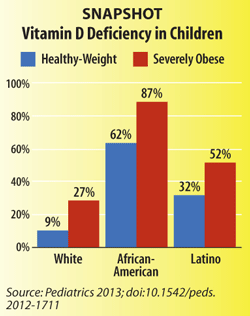Vitamin D Deficiency Worse in Obese, Minority Children
A newly published study in Pediatrics found a high prevalence of vitamin D deficiency in overweight, obese, and severely obese U.S. children, with severely obese minority children especially at risk.
According to the authors, nearly half of all children with severe obesity were vitamin D deficient, and they had more than double the odds of vitamin D deficiency compared with healthy-weight children. The prevalence of vitamin D deficiency went up even more among minority, older, and female children. In particular, the study notes significant racial/ethnic disparities. Among children with severe obesity, only 27% of white children suffered from vitamin D deficiency, while the prevalence in Latino and African-American children was approximately 50% and 90%, respectively.

To assess vitamin D deficiency, defined as 25-hydroxyvitamin-D <20 ng/mL, pediatric researchers analyzed data for 6–18-year-old children (N = 12,711) from the 2003–2006 National Health and Nutrition Examination Surveys.
The study found other factors associated with a notably higher prevalence of vitamin D deficiency, including poverty, winter/spring season of serum collection, no vitamin D supplement use, less milk intake, greater TV/computer use, and less physical activity. On a positive note, many of these factors are modifiable, the researchers noted. For instance, the researchers suggested that supplemental vitamin D and drinking at least two-to-three cups of milk per day may protect against vitamin D deficiency, as might limiting TV/computer use to 2 hours per day or less while also increasing outdoor activity.
Most importantly, the authors suggested routine targeted screening for and treatment of vitamin D deficiency in obese minority children—the most at-risk group—in order to combat this negative nutritional trend.